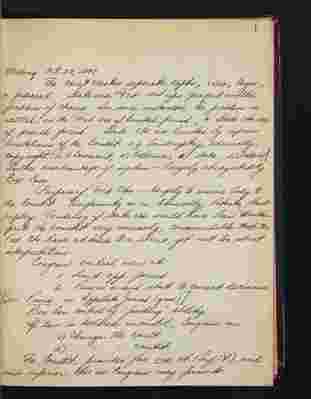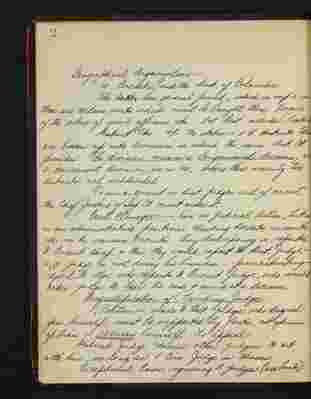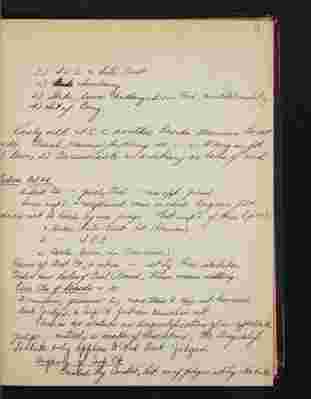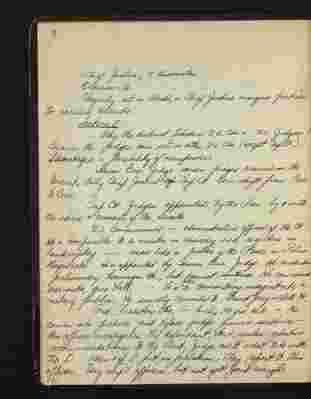Pages
1
This Book Belongs To Frank T. Carr, Law School Univ. of Virginia
Class of Oct. 1948 {Conveyancing} Federal Jurisdiction and Procedure
2
Meeting Oct. 27, 1947 The court creates separate depts., exec, legis., & judicial. State and Fed set ups project another problem of choice. In some instances, the problem is settled, as the Fed. are of limited jurisd., & state cts. are of general jurisd. State cts. are limited by express limitations of the Constit., e.g. bankruptcy, admiralty, copyright. (1.) Concurrent; 2.) Exclusive; a) state; b) federal) Another disadvantage of system — largely abridged by Erie Case. Purpose of Fed. Cts. — largely to [insure] body to the Const. Uniformity as in Admiralty, Patent, Bank— ruptcy. Tendency of state etc. would have been to inter— pret the Const. very narrowly; comendable that the Fed. Cts. have adhered to a strict, yet not too strict interpretation. Congress control over ct. 1. Limit app. jurisd. 2. Pass on amend stat. to correct decisions. (See: Pound on Appellate Jurisd. (good)) Pres has control by "packing" ability. If law is declared unconstit., Congress can 1.) Change the court 2.). " " Constit. The Constit. provides for one ct. (Sup. Ct.), and such inferior cts. as Congress may provide.
3
Geographical Organization: — 10 Circuits, and the Dist. of Columbia. The latter has general jurisd., which is imp't as there are certain suits which must be brought there because of the situs. of gov't officers, etc. 1st Dist. includes Puerto [Rico.] District Cts. w/i the states: — 1-4 districts. These are broken up into divisions in which the same Dist. Ct. presides. The divisions means a Congressional division, not a convenient division, as in Va., where there are only two districts, not subdivided. To send circuit as dist. judges out of circuit, the Chief Justice of Sup. Ct. must order it. Court Manager: — has no judicial duties, but is in an administrative position: checking dockets, accounts, etc. in the various circuits. Any discrepancy is reported to Circuit Chief, & then they will report to Dist. Judge e.g. judge is not doing his business — procastinating — report to Mgr. who reports to Circuit Judge, who will order judge to hear the case & arrive at a decision. Disqualifications of Presiding Judge: — Petition is made to that judge who disqual— ifies himself; must be supported by facts, not opinion or bias — recuses himself. No appeal. District Judge chooses other judges to sit with him, so long as 1 Circ. Judge is chosen. Exceptional cases, requiring 3 judges (see book):
4
1.) I.C.C. & Anti—Trust 2.) Insolvency 3.) State law challenged on Fed. Constitutionality. 4.) Act of Cong. " .
Rarely will I.C.C. or other board's decision be set aside. Usual reasons for doing so: — 1) Wrong in pt. [of] law; 2) Unreasonable or arbitrary on basis of evid.
Lecture, Oct. 29 District Cts. — purely trial — rare app. jurisd. Some imp't & exceptional cases in which Congress felt should not be heard by one judge. Most imp't of these (p. 12): 1) Under Anti—trust Act. (Sherman) 2) " I.C.C. 3) States laws, etc. (see above)
Terms of Dist. Ct., & [situs.] — set by Fed. statute. Under new Rules of Civil Proced., terms mean nothing. Circ. Cts. of Appeals = 10 3 members; quorum = 2; more than 3 can sit however. Dist. Judges, & Sup. Ct. justices can also sit. There is no statute on disqualification of an appellate judge — entirely a matter of discretion; the Disqualif. statute only applies to Fed. Dist. Judges. Organiz. of Sup. Ct. Created by Constit., but no. of judges set by statute.
5
1 Chief Justice; 8 Associates Quorum = 6 They only sit in Wash., & Chief Justice assigns justices to various circuits. Section 7: — Why the distinct. between U.S. Cts. & U.S. Judges? Because the judges can sit in other U.S. Cts. (except Sup. Ct.). Advantages = flexibility of manpower Senior Circ. Judge sends judges around in the Circuit. Only Chief Justices of Sup. Ct. can shift from Circ. to Circ. Sup. Ct. Judges appointed by the Pres. by & with the advice & consent of the Senate. U.S. Commissioner — administrative officer of the Ct. He's comparable to a master in chancery and registers in bankruptcy — more like a Justice of the Peace or Police Magistrate. He's appointed by Senior Circ. Judge. He conducts preliminary hearings, etc., but cannot sentence. He can issue warrants, give bail — he's like a committing magistrate & notary public. He usuallyremands to Grand Jury or Dist. Ct. Fed. Probation Cts. — Only 20 yrs. old — He comes into picture just before judge passes sentence — this officer investigates the defendant, etc. & makes reports & recommendations to the Dist. Judge as to what to do with the D. When & if D put into probation, they report to this officer. Very imp't. officers, but not yet paid enough.




